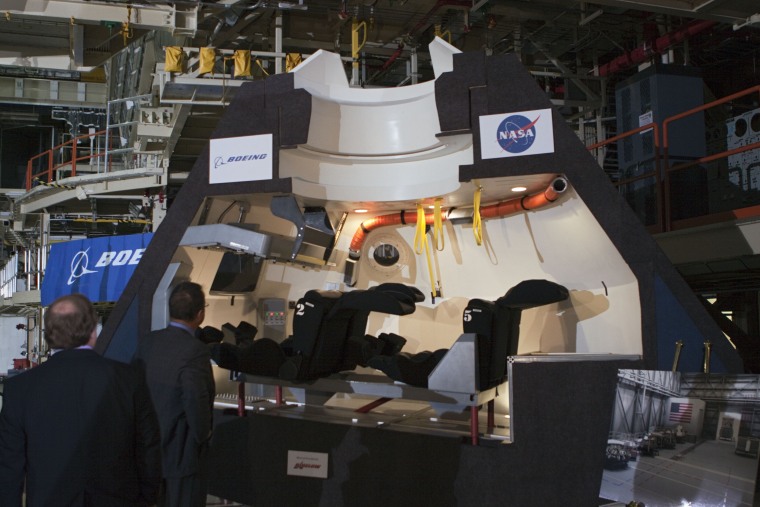Boeing is taking over one of NASA's old space shuttle hangars to build a new capsule that the company hopes will lift astronauts to orbit in four or five years.
More than 100 Boeing, NASA and state and federal officials gathered in the massive empty hangar — Orbiting Processing Facility No. 3 — for the announcement of the first-of-its-kind agreement allowing a private company to take over the government property.
The aerospace company expects to create 550 high-tech jobs at Kennedy Space Center over the next four years, 140 of them by the end of next year. That's less than 10 percent of the approximately 6,000 shuttle jobs lost in Florida over the past several years, but Gov. Rick Scott and other lawmakers at the ceremony said they expect additional hirings by the commercial space industry.
NASA is counting on companies such as Boeing to ferry cargo and astronauts to and from the International Space Station in three to five years. Until then, the space agency will continue to shell out tens of millions of dollars per seat on Russian Soyuz spacecraft.
The Soyuz is the only way to get astronauts to and from the space station, ever since Atlantis returned from the final shuttle flight in July. A Soyuz rocket failure in August highlighted the risk of relying on just one type of craft.
America's last hope
During Monday's hourlong ceremony, lawmakers said the commercial industry is America's last hope, anytime soon, for U.S. astronauts to fly on U.S. spaceships from U.S. soil.
The Obama administration requested $850 million in NASA's 2012 budget for the commercial space effort. The House slashed that to $312 million, but the Senate set the figure at $500 million.
Sen. Bill Nelson, a Florida Democrat and a one-time space shuttle flier, said that $500 million was a reasonable figure, given the nation's current economic situation. However, NASA's deputy administrator, Lori Garver, told journalists that level of funding would "likely add a year's delay" to the plan for commercializing space station transport operations.
Boeing expects to start removing shuttle platforms and modifying the hangar to suit its own purposes in the next few months.
John Mulholland, vice president and program manager of commercial programs for Boeing, said it will be sad to see all the shuttle equipment go.
"The shuttle's such an iconic vehicle. These marvelous buildings have a lot of memory," said Mulholland, a former shuttle manager. "But you've always got to be looking forward. So while the shuttle is remarkable, we're looking forward to the next phase of space exploration."
Boeing wants to ferry astronauts not only to the International Space Station, but to a commercial scientific outpost planned for orbit by Bigelow Aerospace. Each if Boeing's CST-100 capsules would hold seven people. A test flight is planned by 2015.
The agreement calls for Boeing to use the hangar for 15 years, with an option to renew for another five. Then it will be up to Boeing to demolish the building, on NASA's get-rid-of list. Officials stressed that Boeing is not paying NASA any rent. Instead, NASA is turning the facility over to Space Florida, a state economic development agency, which will work out the lease arragements with Boeing.
The hangar is 197 feet long, 1,650 feet wide and 95 feet high. It was last used to ready the shuttle Discovery for its final launch earlier this year.
More deals may be ahead
NASA wants to turn the space center — long a government-only locale — into a multi-user spaceport. Kennedy Space Center's director, Bob Cabana, said that other buildings would go up for grabs, eventually including the center's two other Orbiter Processing Facilities. Space Florida is working on more deals.
In addition to Boeing, three other companies are receiving spaceship development funds from NASA, including SpaceX, Sierra Nevada Corp. and Blue Origin. Sierra Nevada already has an agreement with NASA to use Kennedy Space Center facilities, but it hasn't yet struck a deal with Space Florida like Boeing's.
Space Florida's president, Frank DiBello, said $40 million to $50 million would be invested in upgrading Orbiter Processing Facility No. 3, on a schedule that would be dependent on Boeing's performance on job creation and investment. John Elbon, vice president and general manager of Boeing Space Exploration, said "we're still working on the final details" of the lease plan.
NASA is due to select at least two companies next year to proceed with plans to build spaceships for servicing the space station. During a teleconference with reporters, Elbon confirmed previous statements that Boeing would proceed with its plans for the CST-100 only if it won NASA's commercial space competition.
Throughout the ceremony, NASA officials and others stressed that Kennedy Space Center is not going out of business. "Ladies and gentlemen, the dream is alive," Nelson told the crowd.
President Barack Obama hailed the commercialization agreement in a NASA statement.
"The next era of space exploration won't wait, and so we can't wait for Congress to do its job and give our space program the funding it needs," Obama said. "That's why my administration will be pressing forward, in partnership with Space Florida and the private sector, to create jobs and make sure America continues to lead the world in exploration and discovery."
NASA relinquished its shuttle fleet to concentrate on new rockets and spacecraft that will be able to carry astronauts beyond low Earth orbit. The schedule calls for NASA to send astronauts to a near-Earth asteroid by the mid-2020s, and start manned missions to Mars and its moons in the mid-2030s.
This report includes information from The Associated Press and msnbc.com.
